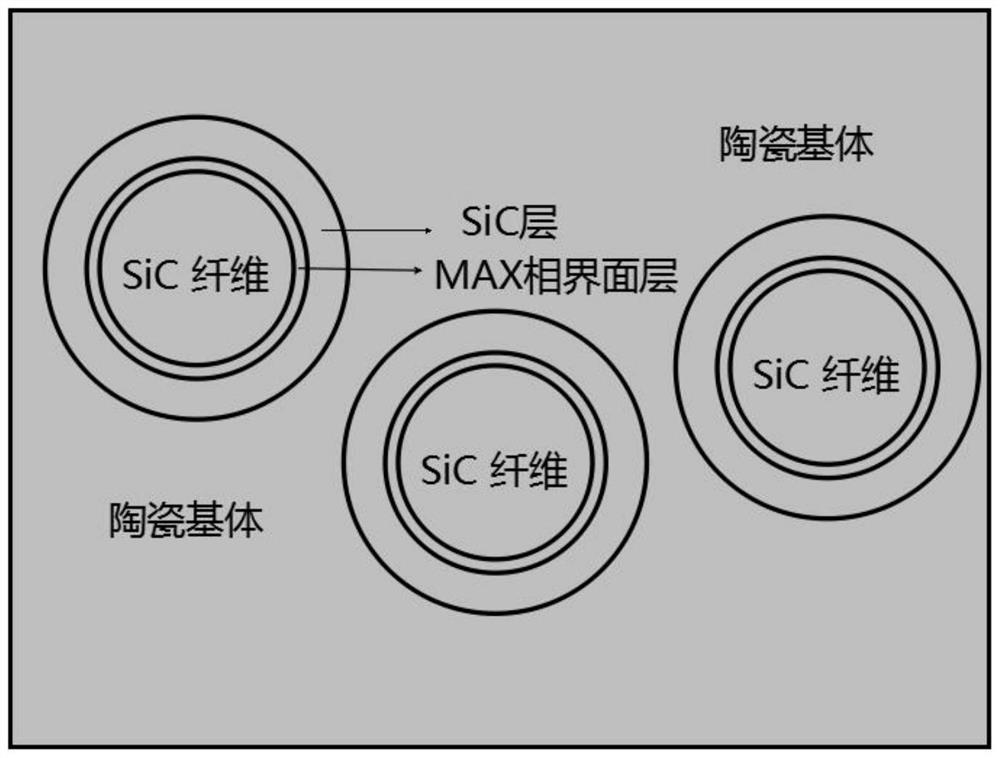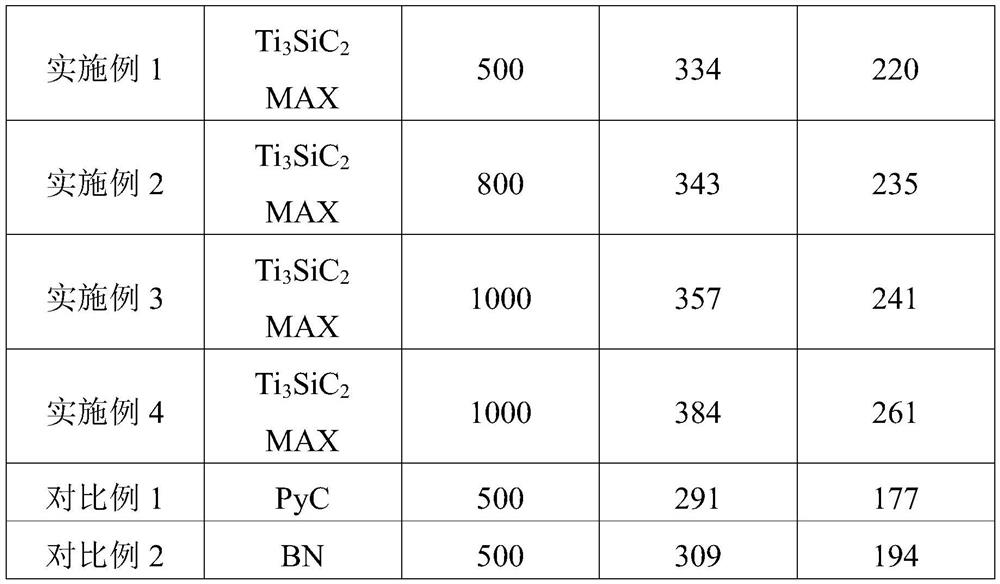Ti3SiC2MAX phase interface layer modified SiC/SiC composite material and preparation method thereof
A composite material and phase interface technology, which is applied in the field of aerospace material preparation technology, can solve the problems of insufficient mechanical properties, poor temperature resistance and oxidation resistance of composite materials in high-temperature air environments, and achieve easy crack deflection, stable performance, crystal The effect of high phase stability
- Summary
- Abstract
- Description
- Claims
- Application Information
AI Technical Summary
Problems solved by technology
Method used
Image
Examples
preparation example Construction
[0023] The present invention provides a Ti in the first aspect 3 SiC 2 The preparation method of MAX phase interface layer modified SiC / SiC composite material, described preparation method comprises the following steps:
[0024] (1) SiC fiber prefabricated body is prepared by SiC fiber, and the first sample is obtained;
[0025] (2) Deposit Ti on the surface of the SiC fiber of the first sample by chemical vapor deposition 3 SiC 2 MAX phase interface layer to obtain the second sample;
[0026] (3) Deposit and prepare a SiC interface layer on the outside of the second sample by chemical vapor deposition to obtain a third sample;
[0027] (4) immersing the third sample in the precursor solution to obtain the fourth sample;
[0028] (5) Carry out curing reaction to the 4th sample, obtain the 5th sample;
[0029] (6) Carry out cracking reaction to the 5th sample, obtain the 6th sample;
[0030] (7) Repeat step (4) to step (6) at least once to obtain the seventh sample con...
Embodiment 1
[0060] (1) Weaving the second-generation SiC fibers into a 2.5D preform to obtain the first sample with a fiber volume fraction of 32%, with a warp density of 7 fibers / cm and a weft density of 3 fibers / cm.
[0061] (2) Select titanium tetrachloride and hydrogen as precursors, and deposit on the fiber surface of the sample with a chemical vapor deposition furnace under the conditions of 1000°C and -0.04MPa for 1h to obtain a 500nm thick Ti 3 SiC 2 MAX phase boundary layer to obtain the second sample.
[0062] (3) Move the second sample to a chemical vapor deposition furnace, use trichloromethylsilane as a precursor, and deposit it at 1200 ° C and -0.05 MPa vacuum for 45 hours to obtain a SiC interface layer with a thickness of 3.5 μm. The third sample.
[0063] (4) The konone xylene solution was selected as the impregnation precursor, and the third sample was immersed in the precursor at 70° C. and 2 MPa high pressure for 1.5 h to obtain the fourth sample.
[0064] (5) Unde...
Embodiment 2
[0070] (1) Weaving the second-generation SiC fibers into a 2.5D preform to obtain the first sample with a fiber volume fraction of 39%, with a warp density of 8 fibers / cm and a weft density of 3.5 fibers / cm.
[0071] (2) Select titanium tetrachloride and hydrogen as precursors, and deposit 1.5h on the fiber surface of the sample with a chemical vapor deposition furnace under the conditions of 1000°C and -0.04MPa to obtain 800nm thick Ti 3 SiC 2 MAX phase boundary layer to obtain the second sample.
[0072] (3) Move the second sample to a chemical vapor deposition furnace, use trichloromethylsilane as a precursor, and deposit it at 1200 ° C and -0.05 MPa vacuum for 80 h to obtain the first sample containing a SiC interface layer with a thickness of 4 μm. Three samples.
[0073] (4) Furfural xylene solution was selected as the impregnation precursor, and the third sample was immersed in the precursor at 70° C. and 2 MPa high pressure for 1.5 h to obtain the fourth sample. ...
PUM
| Property | Measurement | Unit |
|---|---|---|
| thickness | aaaaa | aaaaa |
| thickness | aaaaa | aaaaa |
| density | aaaaa | aaaaa |
Abstract
Description
Claims
Application Information
 Login to View More
Login to View More - R&D
- Intellectual Property
- Life Sciences
- Materials
- Tech Scout
- Unparalleled Data Quality
- Higher Quality Content
- 60% Fewer Hallucinations
Browse by: Latest US Patents, China's latest patents, Technical Efficacy Thesaurus, Application Domain, Technology Topic, Popular Technical Reports.
© 2025 PatSnap. All rights reserved.Legal|Privacy policy|Modern Slavery Act Transparency Statement|Sitemap|About US| Contact US: help@patsnap.com



